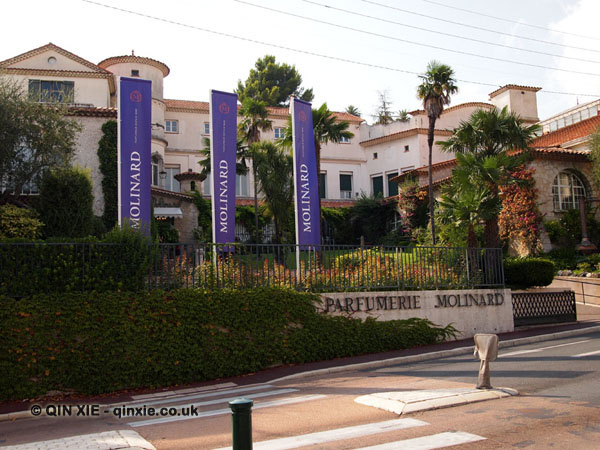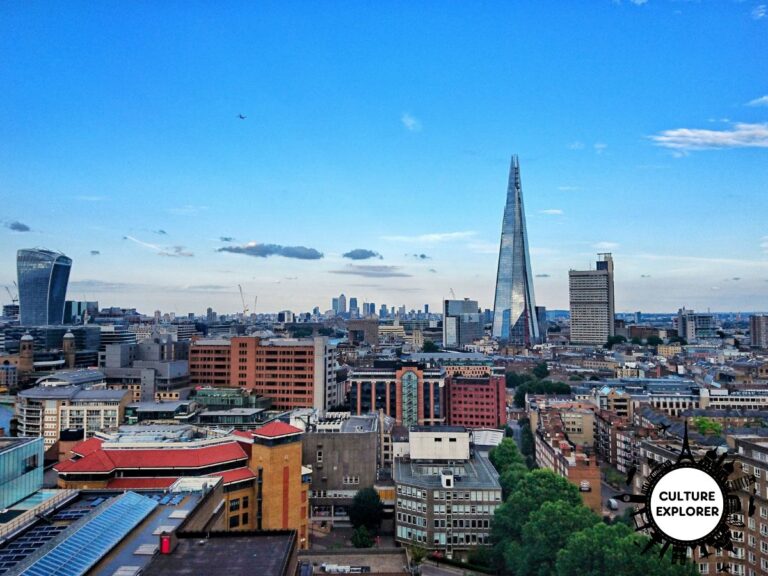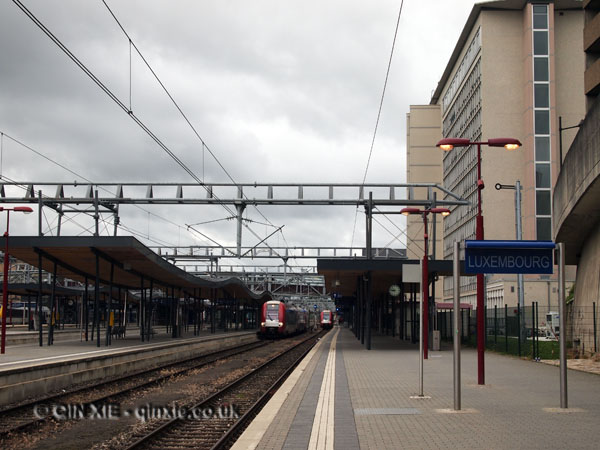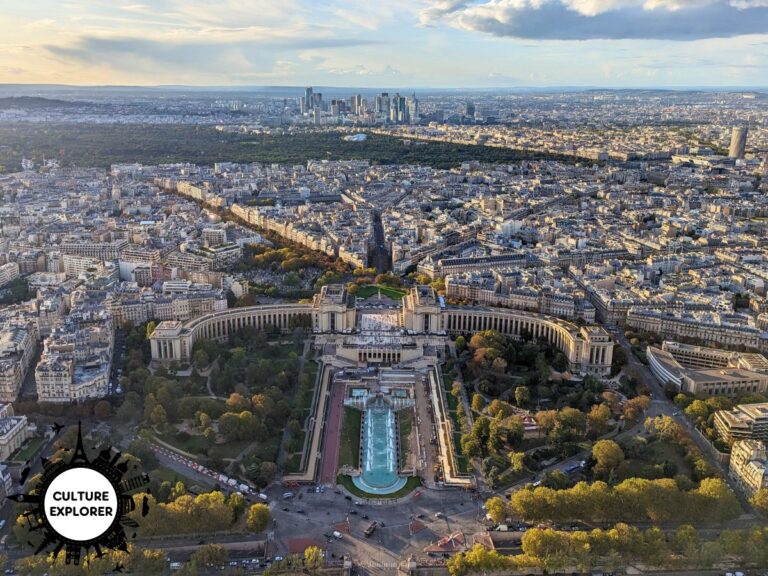How to get to Paris: Your trip planning guide
Culture Explorer uses affiliate links, including those from Amazon, which are identified using an *. If you buy something through the link at no extra cost to you, Culture Explorer may be paid a commission, which helps to fund running of the site. You can read more about this here.
Paris draws visitors from all over the world with its architectural icons, world-class museums and art galleries and design-led boutiques.
But it’s also a city that’s very much lived in, with a lively buzz about it.
You can go high octane with a shopping spree along the Champs-Élysées and dinner at Le Jules Verne, the two Michelin-starred restaurant in the Eiffel Tower, followed by one of the many cabaret shows in the city*.
And you can just as easily go budget and while away your time with walks by the river Seine, lazy days in landscaped parks, and people-watching from pavement cafes.
I’ve been to Paris a bunch of times. Here are my tips for planning a trip to Paris.
Best time to visit Paris
There’s plenty to do in Paris year-round, and something charming about every season, so there’s no true best time of the year to visit the city.
That said, the French capital tends to be at its loveliest in spring and summer.
From the end of February to early April for example, you’ll spot cherry blossoms in bloom, with Tuileries Garden and Trocadéro Gardens the best places to see these pink flushes of spring.
As temperatures warm up for the summer months, Paris’ pavement cafes become hot property for people watching with a glass of wine, or al fresco dinners late into the night.

Autumn can be windy.
But wrap up in a chic jacket and those walks by the Seine, lined with trees flecked with gold, become the perfect prelude to a chocolat chaud in a cosy cafe, or comfort food in a homely bistro.
And then there’s winter, which can be cold and wet.
So head for landmarks like the Hôtel de Ville (Paris city hall) or the Church of Saint-Germain-des-Prés to sip mulled wine as you bask in the warm glow of fairy lights.
How to get to Paris
By plane
Flights from London to Paris take around 1 hour 20 minutes.
The nearest airport is Paris Orly; it’s where most budget airlines fly into.
From there, the Paris Metro Line 14 takes you into the heart of the French capital, to Gare de Lyon, in under 30 minutes.
Charles de Gaulle Airport is much better known, and where premium airlines fly into.
It’s also pretty close to the city – the Paris RER B line takes you to Gare du Nord in the centre in 35 minutes.
By train
Getting the Eurostar? You’ll enter and leave Paris from Gare du Nord.
The journey from King’s Cross St Pancras in London normally takes around 2 hours and 16 minutes.
For fast trains out of Paris to other cities, you’ll likely depart from Gare d’Austerlitz, Gare de Bercy, Gare de l’Est, Gare de Lyon, Gare Montparnasse, or Gare du Nord.
By other means
You can get the coach from London to Paris. It’ll take at least 9 hours, but can be much cheaper than flying or getting the Eurostar, especially if you’re travelling last minute.
Check Flixbus* or Omio* for tickets.
If you’re taking your own car, you’ll need to take either the Eurotunnel Le Shuttle or a ferry – tickets for both can be booked with Direct Ferries*.
The Eurotunnel Le Shuttle gets you from Folkestone to Calais in 35 minutes, and then it’s a 3 hour drive to Paris.
For ferries, the closest port is Dover; it’s 1 hour 35 minutes to 2 hours to get to Calais.
Where to stay in Paris

Paris is incredibly well connected by public transport so where you stay in the city won’t make a huge amount of difference.
It’s also a pretty compact city, so even the 20th arrondissement isn’t that far away.
That said, if you stay in any of the first eight arrondissements, you’ll be able to walk pretty much anywhere, assuming you’re reasonably active and have no mobility issues.
Personally I’d go with Le Marais, which is split across the 3rd and 4th arrondissements.
You’ll find photogenic cobbled streets and bakeries selling fresh croissants right on your doorstep.
The 8th arrondissement is also a great option – it’s well connected, especially if you’re around the Champs-Élysées.
Best hotels in Paris
Hotel prices in Paris are usually pretty high. Expect to pay at least €80 a night for a decent hotel.
Of course, depending on what you’re looking for, prices can swing a lot in either direction.
Here are my picks for some special places to stay.
Budget: Le Village Montmartre by Hiphophostels
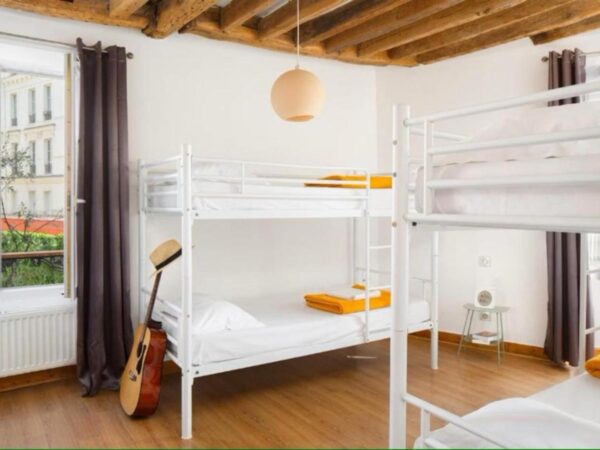
Le Village Montmartre by Hiphophostels offers a good balance between price and location.
It’s on the expensive side for a hostel, but for that you get a base by Montmartre Hill, just a short stroll from the steps up to the Basilique du Sacré-Cœur.
There’s an outdoor terrace for breakfast or evening drinks, and plenty of places to work for digital nomads – it bills itself as a hostel and co-living space.
Price: From £43 | $55 | €50 a night, bunk bed in a dorm.
Address: 20 Rue d’Orsel, 75018 Paris, France.
Book your stay on Booking.com* or Expedia*.
Mid-range: Hotel Atala

Hotel Atala is just a five minute walk to Champs-Élysées and has great transport links to other parts of the city.
It’s a four-star property, with a big focus on art and design.
But the best thing about this property is that some rooms have terraces with a view of the Eiffel Tower.
You can read more about the property in my review of Hotel Atala.
Price: From £232 | $301 | €276 a night, room-only.
Address: 10 Rue Chateaubriand, 75008 Paris, France.
Book your stay on Booking.com* or Expedia*.
Luxury: Le Pavillon de la Reine
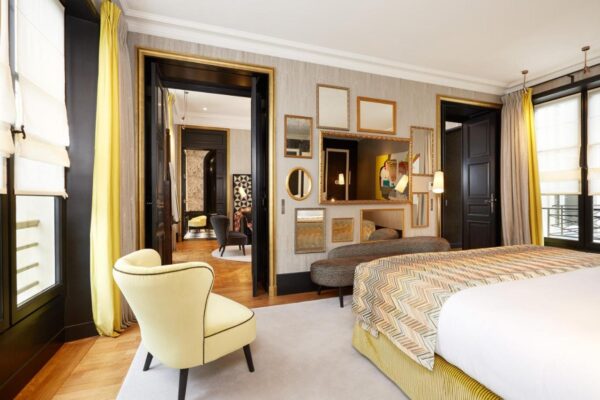
Facing Place des Vosges, the oldest square in Paris, Le Pavillon de la Reine is a luxury hotel with character in abundance.
The smallest rooms are on the top floor, in what would have been the servants’ quarters, while the biggest suites are essentially an apartment.
What makes this luxury hotel particularly attractive is the fact that it has a private courtyard – it makes it an exceptionally tranquil place to stay.
Price: From £506 | $646 | €590 a night, room-only.
Address: 28 Place des Vosges, 75003 Paris, France.
Book your stay on Booking.com* or Expedia*.
Unique: Maison Souquet
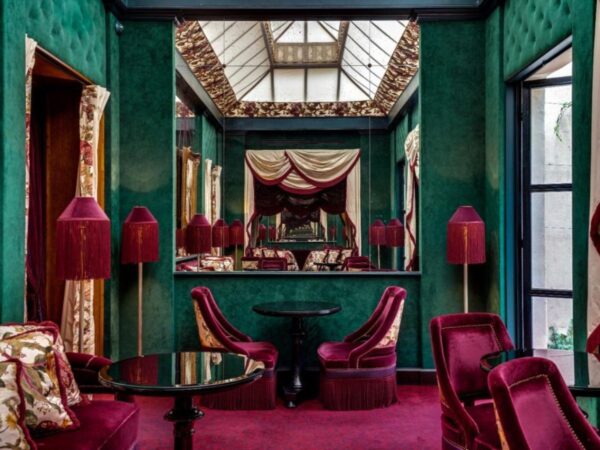
Designed with romance in mind, Maison Souquet is inspired by the Red Light district of Paris; the Moulin Rouge* is just around the corner.
The hotel takes its name from a “pleasure house”, and each of its 20 rooms and suites is dedicated to a famous courtesan.
As you can expect, it’s decadently decorated, with plush carpet, burgundy velvet and glitz chandeliers everywhere.
Price: From £450 | $575 | €525 a night, room-only.
Address: 10 Rue de Bruxelles, 75009 Paris, France.
Book your stay on Booking.com* or Expedia*.
How to get around Paris
Paris is very walkable. If you have the time and are so inclined, you can forgo public transport completely.
To save time, hop on the city’s extremely efficient Metro system – few journeys will take more than half an hour.
You’ll need to get a Navigo card, which can be used on the Metro system, RER trains, trams, and buses.
These can be picked up at any of the Metro or RER stations, and loaded with tickets or travel packages.
Which Navigo card to go for
The Paris Visite package is designed for tourists. Tickets will give you unlimited travel in Paris for up to five days.
Tickets for Zones 1 to 3 in central Paris – so around any and all of the 20 arrondissements – start from €13.95 a day.
For Zones 1 to 5, which includes tickets to and from the airport, and regional trains like those to Disneyland Paris and the Palace of Versailles, starts from €29.25 a day.
If you don’t think you’ll use public transport a lot, you might find it cheaper to get a Navigo Easy travel card – this is what I use every time I’m there.
You can load it with a single ticket for €2.15, or 10 tickets for €17.35. You can also top up using your phone via the Île-de-France Mobilités app.
Other essentials
Currency
Paris uses the euro, and you can pretty much get around the city without having any cash.
Language
The official language in Paris is of course French.
For English speakers, it’s helpful to know one or two French words, such as bonjour (good day) and merci (thank you).
Most younger Parisians will speak some English so you can get around without knowing any French, but people tend to be more friendly if you speak a little French or at least try.
Wifi and connectivity
Paris has some of the world’s fastest internet so if you’re travelling there for work, you won’t have issues finding good connectivity.
For tourists, lots of public spaces and key tourist attractions offer free wifi, including the Louvre and Eiffel Tower, so you can navigate the city relatively easily.
Most hotels will offer free wifi too.
For ease, I always like to have a sim card that lets me roam for free.
If your mobile network doesn’t include free EU roaming, you can get a temporary e-sim from the likes of Airalo*.
Their data-only e-sims are valid for anywhere between seven days to 30 days, and you can choose from country-specific options or regional ones.
For France, prices start from $4.50 for 1GB of data that’s valid for seven days.
Their prices are always in US dollars so make sure the card you’re paying with won’t charge you extra for foreign currency spending.
Safety
Paris is generally safe for visitors during the day, especially in busy touristy areas.
You should be careful at night though, as some places are known for higher crime rates.
This includes the areas around Pigalle, Gare du Nord and Gare de l’Est.
Bag snatching and petty theft is common so keep an eye on your belongings. Violent mugging can also occur.
Look out, too, for protests as these can often turn violent with little to no notice.
Additional resources
You might want to check out Paris je t’aime, the website of the official tourist board – it has a list of things to do in the French capital each month.
A good book to read is Sundays in Paris*, a curated list of the best places to eat, drink and explore on a Sunday by Parisian Yasmin Zeinab.
And for an insight on what it’s like to live in Paris, try The Sweet Life in Paris* by David Lebovitz.
Pin this for later


